
by Erik Lovestrand | Jun 30, 2017
Imagine yourself as an early settler, migrating with your family into the area known as La Florida, with the hope of staking a claim and building a new life. You’ve heard stories of horrendous mosquitos, fierce native peoples, deadly snakes, and giant alligators. Regardless, the promise of abundant fish and wildlife, a year-round growing climate and a chance to start anew, override any doubts you might have and you pack your wagon, hitch up your mules and head south with great anticipation.
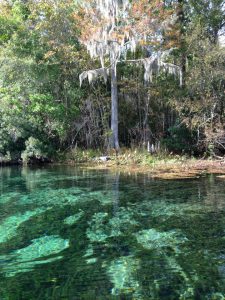
Florida’s springs are world famous. They attracted native Americans and settlers; as well as tourists and locals today.
Photo: Erik Lovestrand
Well, the mosquitos have been horrendous, one of your mules was bitten by a rattlesnake but survived, and one of your hounds was taken by an alligator at a river crossing. You are in your second month of travel and you’ve come into a strange area of forest that stretches for miles in all directions. Deep, white sands clutch at your wagon wheels and make tough going for the mules. The land is forested by tall majestic pines and the terrain is gently rolling with an open view across a landscape dominated by wiry grasses and other low growing herbaceous plants. The buzzing sound of insects in the trees makes it seem even hotter for some reason and everyone is tired and thirsty as you spy a dark line of hardwood trees just down-slope. You decide to take refuge in the shade to rest the lathered mules and hope for a water source to refill your dangerously low water cask.
As you walk back under the shady canopy you find an obvious trail that has been used by other humans for generations as evidenced by a deep rut worn into the ground between exposed limestone boulders. As luck would have it, you see the glint of water through the trees ahead. When you clear the trees near the water’s edge you stop abruptly in stunned amazement. The image of a deep blue pool of crystal clear water with a small stream exiting into the woods causes you to shake your head in disbelief. You must be dreaming, as you’ve never witnessed such a magical setting; water boiling out of a gaping hole in the earth, surrounded by white sand and long flat blades of grass waving in the current.
Just about everyone who has visited one of our sparkling North Florida springs probably has a similar, magical recollection of their first encounter. As surface water percolates downward through soil layers and the porous karst (limestone) bedrock, it is filtered and cleaned to incredible clarity. The clear water gushing forth in these artesian-spring flows remains 69-70 degrees year-round in our Panhandle springs. This is due to their open aquifer connection, from which many homes draw their drinking water directly.
However, there are some serious vulnerabilities that our springs are facing regarding the quality of the water that they provide for residents and visitors alike. One issue relates to the numerous sink holes throughout our landscape that also connect directly to this same Floridan aquifer. In the past, many of these holes have served as dumping grounds for items ranging from household garbage, to junk cars, old washing machines and refrigerators, and even the occasional murder victim. Imagine all of the pollutants that end up in our drinking water supply as a result of this. Another concern relates to pollution that goes onto the ground surface and ends up in the aquifer. This happens via runoff from paved surfaces, sediments and excess fertilizers or pesticides from the landscape, or even the intentional application of treated wastewater in spray fields located in a “spring-shed.” Water clarity and quality at many of our well-known springs has suffered from excess nutrients that cause algal growth and other unwanted, nuisance plant proliferation.
As we gain a better understanding of how water moves through our landscape and ends up flowing from these natural springs, we should become better stewards by minimizing our human impacts that degrade spring water quality. Let’s keep the magic alive for all of our future generations of nature explorers.
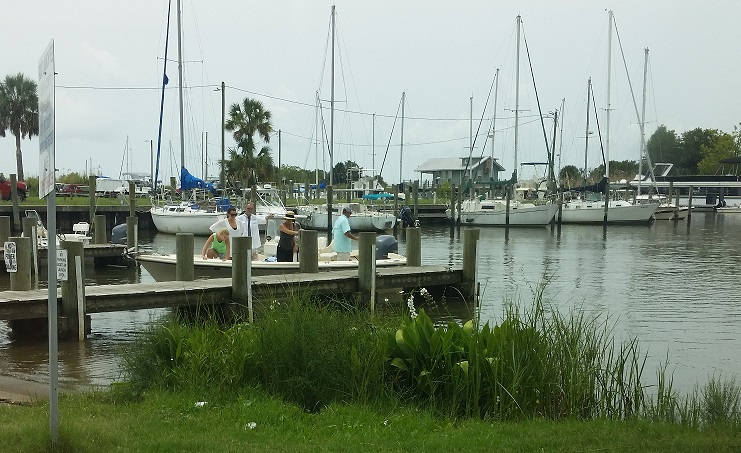
by Erik Lovestrand | Jun 3, 2017
Anticipation of the catch is what thousands of Panhandle boaters will have on their minds as they leave the docks this summer for a day of fishing. However, a hasty departure in their excitement to get to that favorite spot may be the recipe for an outing some would prefer to forget; or worse, a tragedy that could have been prevented.
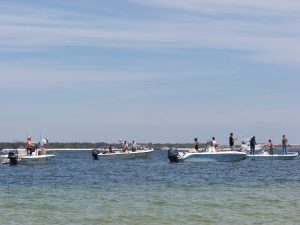
Inshore fishing near Pensacola Pass
Photo: Molly O’Connor
Here are a few things to consider when planning a day on the water that will greatly increase your odds of having success in what matters most; a fun day and safe return for all. Heck, you can always make up some fish stories.
Equipment Check: A basic safety check involves many key aspects that can make or break a trip.
Trailer: (current tag, tires, lights, tie downs, safety chain and winch condition)
Boat: (current registration, navigation gear, vhf radio, motor condition, fuel/oil check, navigation lights, battery, anchor and rope, boat plugs, paddles)
Safety equipment: (flares, fire extinguisher, personal flotation, emergency locator beacon, sound producing device)
Tools: (basic kit with vice grips, needle nose pliers, wire cutters, screw drivers, adjustable wrench, etc.)
Miscellaneous: (sun screen, food, hat, rain gear, polarized glasses, drinking water, cell phone, dry bag, first-aid kit, medicine)
Fishing gear and bait, of course! (Insert garage full of “stuff” here)
Refer to this Fish and Wildlife Conservation Commission (FWC) LINK to know the legal requirements for safety gear on the size vessel you will be using. These vary depending on the length and design of the hull. In addition, the FWC provides information on the Boating Safety Education Course that is a requirement for anyone born on or after January 1, 1988; and a good idea for us “more mature” folks too.
Even if you are not taking to the water in a powerboat, many of the same common-sense and legal requirements apply to personal watercraft, kayaks and canoes. This FWC LINK provides the requirements for class-A recreational vessels less than 16 feet in length and canoes and kayaks.
In addition to all of the “stuff” you’ll need for a good day, you should also have knowledge of the waters that you will be boating on. Appropriate navigational charts are important but first-hand knowledge is always the best. If you are not familiar with the area you are boating on, at least talk to someone you know who has been in that area. It wouldn’t be a bad idea to take along this friend, who would probably enjoy a day on the water too.
When you think about it, there really is a lot of stuff to keep up with when you are going out on the water as the responsible party. But the last thing you want to do is skimp on the safety aspects of your planned adventure. You would be better off to have left your favorite rod in the garage, next to your lucky hat.
by Erik Lovestrand | Feb 27, 2017
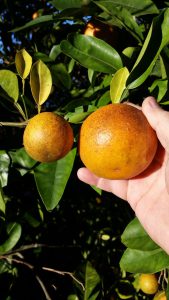
Fruits on HLB infected trees ripen prematurely, are small, and often drop from tree. Photo credit: Erik Lovestrand
If we look at the big picture when it comes to invasive species, some of the smallest organisms on the planet should pop right into focus. A microscopic bacterium named Candidatus Liberibacter asiaticus, the cause of Citrus Greening (HLB), has devastated the citrus industry worldwide. This tiny creature lives and multiplies within the phloem tissue of susceptible plants. From the leaves to the roots, damage is caused by an interruption in the flow of food produced through photosynthesis. Infected trees show a significant reduction in root mass even before the canopy thins dramatically. The leaves eventually exhibit a blotchy, yellow mottle that usually looks different from the more symmetrical chlorotic pattern caused by soil nutrient deficiencies.
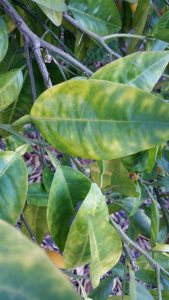
HLB, referred to as “Yellow Dragon” in China, causes an asymmetrical pattern of chlorosis in citrus leaves. Photo credit: Erik Lovestrand
One of the primary vectors for the spread of HLB is an insect called the Asian citrus psyllid. These insects feed by sucking juices from the plant tissues and can then transfer bacteria from one tree to another. HLB has been spread through the use of infected bud wood during grafting operations also. One of the challenges with battling this invasive bacterium is that plants don’t generally show noticeable symptoms for perhaps 3 years or even longer. As you would guess, if the psyllids are present they will be spreading the disease during this time. Strategies to combat the impacts of this industry-crippling disease have involved spraying to reduce the psyllid population, actual tree removal and replacement with healthy trees, and cooperative efforts between growers in citrus producing areas. You can imagine that if you were trying to manage this issue and your neighbor grower was not, long-term effectiveness of your efforts would be much diminished. Production costs to fight citrus greening in Florida have increased by 107% over the past 10 years and 20% of the citrus producing land in the state has been abandoned for citrus.
Many scientists and citrus lovers had hopes at one time that our Panhandle location would be protected by our cooler climate but HLB has now been confirmed in more than one location in backyard trees in Franklin County. The presence of an established population of psyllids has yet to be determined, as there is a possibility infected trees were brought in.
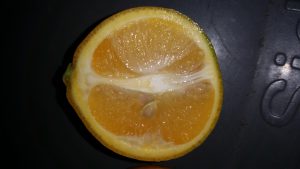
Another symptom of citrus greening is small, lopsided fruit that are often bitter. Photo credit: Erik Lovestrand
A team of plant pathologists, entomologists, and horticulturists at the University of Florida’s centers in Quincy and Lake Alfred and extension agents in the panhandle are now considering this new finding of HLB to help devise the most effective management strategies to combat this tiny invader in North Florida. With no silver-bullet-cure in sight, cooperative efforts by those affected are the best management practice for all concerned. Vigilance is also important. If you want to learn more about HLB and other invasive species contact your local UF/IFAS Extension office.
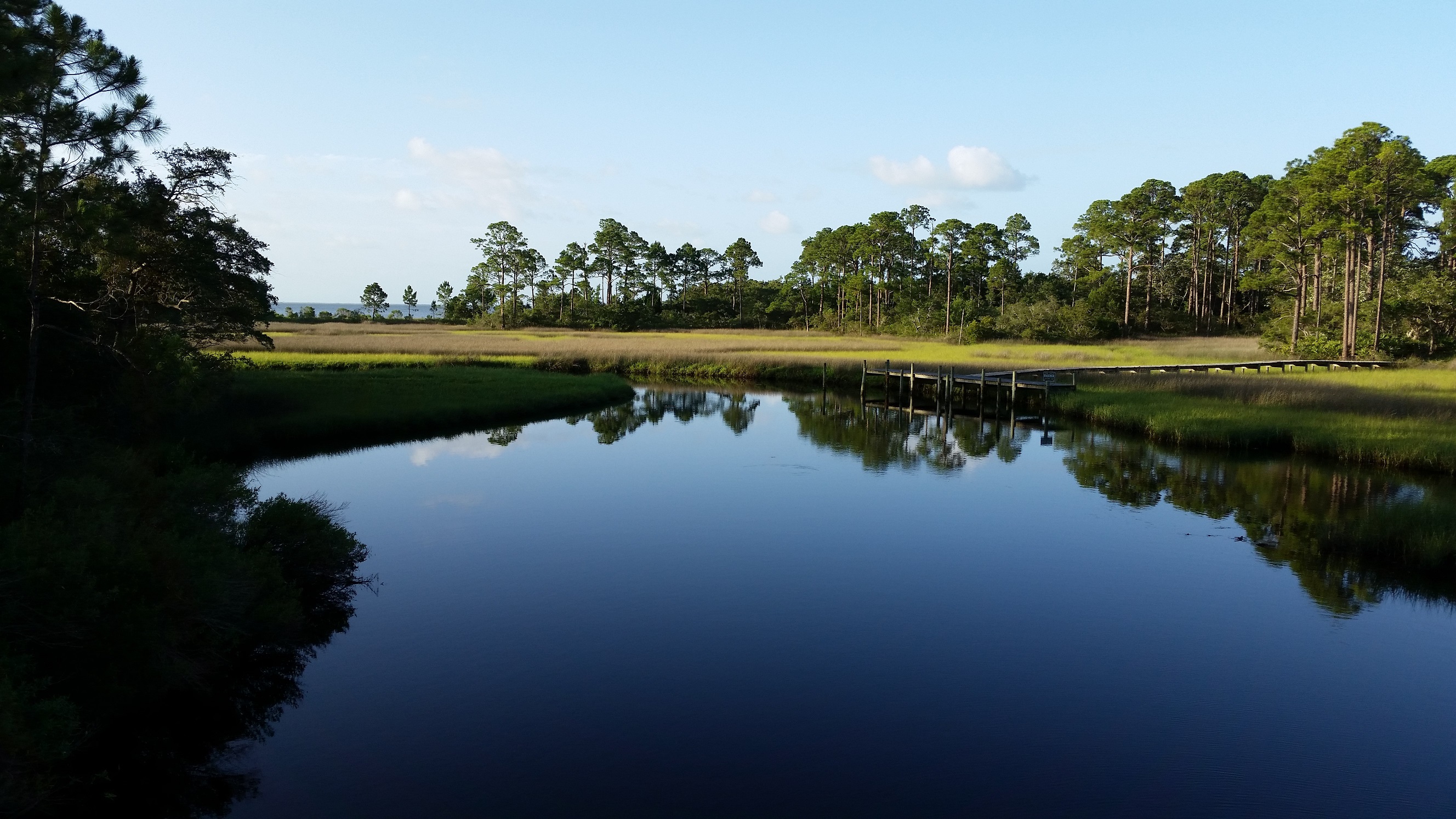
by Erik Lovestrand | Aug 13, 2016
The Florida Panhandle is fortunate to have an abundance of salt marsh habitat fringing many of our coastal environs. Although this habitat may not receive the appreciation it deserves by those seeking a white-sandy beach, it is intricately linked with many of the natural treasures we are blessed with. Salt marshes occur in the ecotone where the land connects with the salty water and they are occupied by a special assemblage of salt-tolerant, hydrophytic plants that provide benefits on many levels. Literally, levels that stretch vertically from the substrate to the tops of the grasses, and horizontally as the plant species are arranged into different zones depending on water depth. These habitats typically occur in coastal areas of lower wave energy, where the marsh plants can establish and thrive. Often this is in our bays and estuaries that are afforded some protection from storms that blow in from the open Gulf. Looking from the land outward, the classic salt marsh vegetation zones begin with the high-marsh which only gets inundated during extremely high tides. This area is dominated by a grass called marsh hay (or salt meadow) cordgrass (Spartina patens) that grows in wiry-leaved clumps. You can also find salt grass (Distichlis spicata) which has shorter, flat leaf blades that project from the stem at a distinctive angle. The mid-marsh zone is typically in and out of the water on daily tides and is usually dominated by a species of rush called black needlerush (Juncus roemerianus). The low-marsh grows in an area that stays under water much of the time and is inhabited primarily by smooth cordgrass (Spartina alterniflora) in our Gulf Coast marshes.
Ecologically speaking, you might deduce that salt marshes are not incredibly diverse, at least as far as plant species inhabiting them. However, the structure, cover and vegetative food components that are available here support a tremendous assortment of animals; some that we depend on for seafood, some that our seafood depends on in a complex food web, and others that are simply a pleasure to know about. Many utilize these grassy nearshore areas during the juvenile portion of their life cycle. Baby crabs, shrimp and fish find many of their needs met here. Just spend a few minutes quietly observing in this habitat and you’ll be amazed when you notice the baby mullet, spotted sea trout, redfish, killifish, fiddler crabs, and a host of other creatures going about their “marshy” business. It is also a special treat to conduct a nighttime investigation with a flashlight here. Just wear protective shoes as oysters often grow in these places.
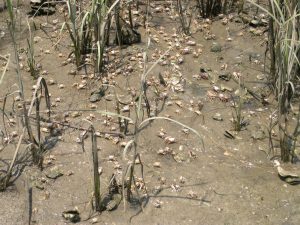
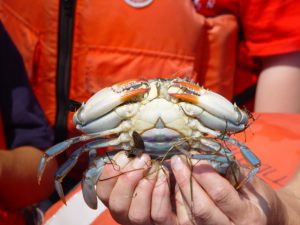
Blue Crabs and Fiddler Crabs Both Grow Up in the Marshy World
One group of animals that depends on this habitat is our coastal bird life. In fact, there is a subset of birds here that has been dubbed with the title “secretive marsh birds,” because they rarely come into the open where people can see them. This group includes several species of rails, bitterns, gallinules and others. Scientists have been concerned about declines in many of these species so standardized methods have been developed to survey them using broadcast recordings to elicit vocalizations that can be counted by researchers. There are also many not-so-secretive marsh birds that find their needs met in our marshes. Harriers visit during the winter months, blackbirds and sparrows find nesting cover here, and egrets, herons and kingfishers dine on the fish and invertebrates that are abundantly plentiful during key stages of their nesting and chick raising cycles.
Last but not least (in my book) are a couple of reptiles that can be found in our saltmarshes. The gulf salt marsh snake (Nerodia clarkii) uses the marsh for cover and to find its preferred diet of small fish, crabs, shrimp and other invertebrates. They spend their days generally hiding under debris, being more active at night. They can be recognized by their four lengthwise yellowish stripes and the fact that you aren’t likely to find another snake in the saltmarsh. However, I have seen a cottonmouth or two spending time here, so be careful. The other unique reptile we can find in select areas of our marshy coastline is the ornate diamondback terrapin (Malaclemys terrapin macrospilota). These charismatic coastal turtles are sexually dimorphic, with males only reaching about five inches and females growing to around eight inches. The yellow centers on the dark scutes of the back are a definitive identification feature, along with very pale gray skin that may be speckled with black dots. Terrapins feed primarily on mollusks and crabs and use the adjacent upland areas for laying their eggs. Terrapins have suffered dramatic declines throughout their range because they are attracted to bait in crab traps and can be trapped and drowned. There is a simple conservation solution though. If you are in an area that terrapins frequent you can install a rectangular exclusion device in your trap funnels that will keep out terrapins but let crabs through. Awesome invention!
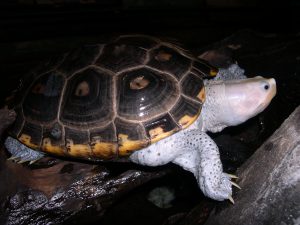
Ornate Diamondback Terrapins Depend on Coastal Marshes and Sea Grass Habitats
Take some time to visit our incredible coastal marshes and appreciate the diversity of life they provide us, along with the most profound serenity of any beautiful, wide-open vista that you’ll ever find anywhere.
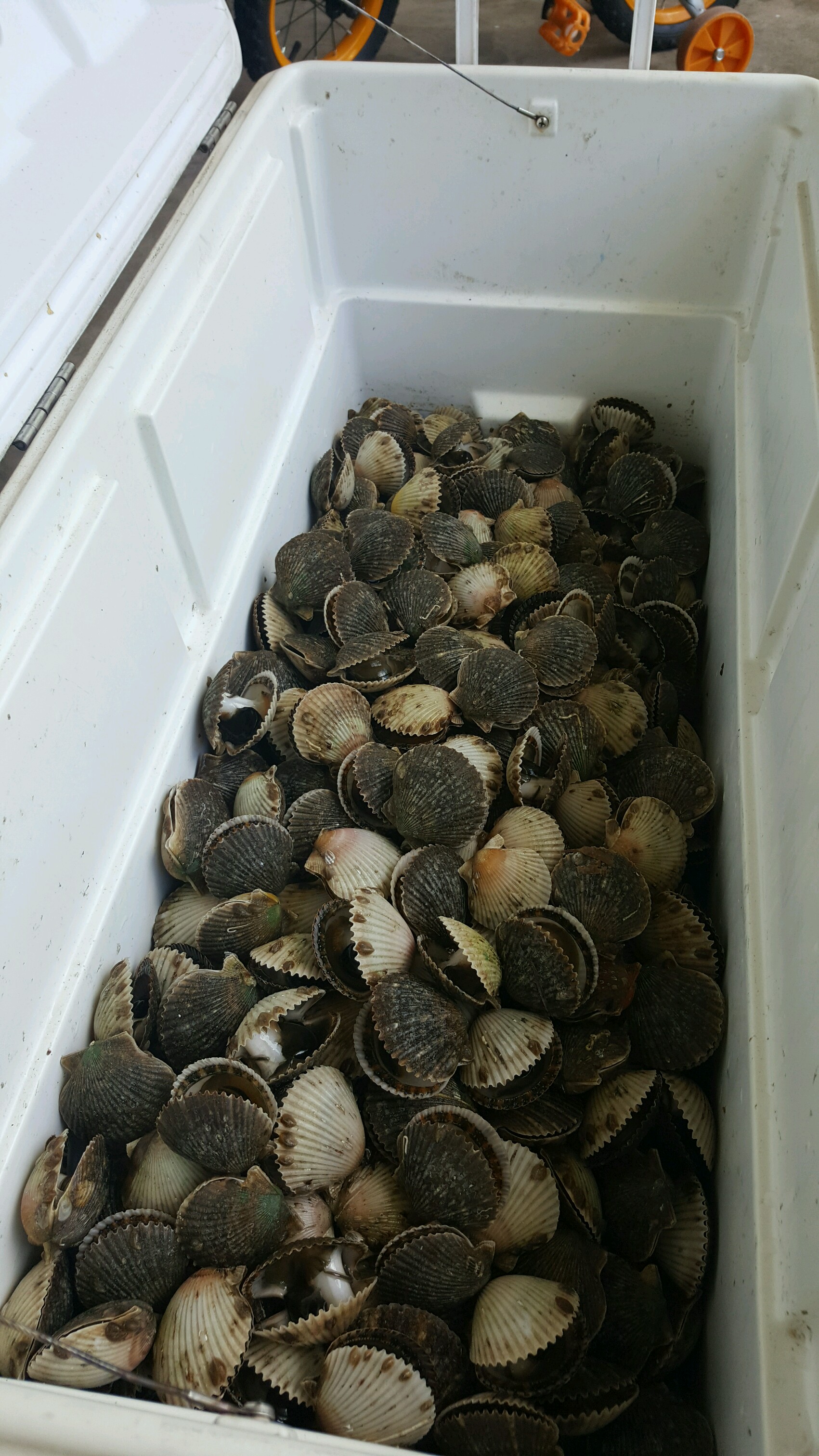
by Erik Lovestrand | Jul 31, 2016
If you have done this phenomenal summertime activity, then you know what I’m talking about. And it’s not just the kids that derive an amazing, nature-based educational experience. Anyone who puts on a mask and snorkel for their first scalloping adventure is about to have their world “rocked” in a good way. Gliding over the shallow seagrass meadows where these bivalves live will produce a sensory experience of sights and sounds like never before.
Florida’s bay scallop (Argopecten irradians), is a mollusk with a well-deserved reputation for being fun to harvest and scrumptious on the dinner plate. However, before you hit the water, there are a few things to consider that will make your scalloping experience safe, enjoyable and educational. Information provided in this article should give you the basics and hopefully encourage you to participate in this Florida Bigbend/Panhandle area’s best reality-show ever!
Know Before You Go: The Florida Fish and Wildlife Conservation Commission governs the rules regarding scalloping zones, license requirements, harvest limits, seasons, gear requirements, and boating laws. For detailed information visit the FWC website on the topic. Take time to review this information so that you are safe and legal when on the water.
Finding the Critters: As always, it is best to know someone who has already been out and can point you to a good location. Barring that scenario, simply search the internet or Facebook, or call the local dive shop or bait and tackle store that sells gear. People are generally very kind in this regard and will at least get you close to the right spots. When you get close, just look for where the boats are gathered. Don’t waste your time trying to find a secluded spot of your own because those boats are there for a good reason. Move at an idle speed and be very careful approaching other vessels. You should be looking for swimmers at all times as some will stray far from their anchored boat with the dive flag displayed. Legally, you are supposed to stay 300 feet from a displayed diver down flag in open waters.
Boat Safe and Smart: The shallow nature of most scallop habitat requires that you understand tidal cycles in the area where you are boating. It is not at all pleasant to be stranded and waiting for the next high tide before you can go home with your catch. In addition to the inconvenience, there are other more serious consequences that may occur in this situation. Often, boaters will realize too late that they have been caught by low water and, whether out of fear or ignorance, start up the motor and attempt to leave in a hurry. This can result in a dangerous grounding at high speed, damage to the vessel or motor, and serious propeller scarring in the very seagrass beds that support the scallops and a host of other amazing species. Best bet, if you can’t put your motor down without it being in the grass, attempt to wade it out to deeper water before starting the motor.

Safety check on equipment before leaving…

…Often leads to a successful adventure!
Keeping the Catch: If you are not shucking your scallops right on the boat as they are caught you need to protect them for the trip home. The safest way is to place your live scallops on ice in a cooler under shade. When cleaning the catch, it is handy to have a bowl with some ice water handy to drop the meats into for quick chilling. This also keeps them plump and moist for cooking. An old butter knife with a slight bend at the tip works well for shucking and many people even use a spoon if they don’t already have an official scallop knife. Check out this Florida Sea Grant scallop brochure for a couple of tasty recipes for after the shucking is done.
In the end, you are ultimately responsible for whether or not you have a safe, enjoyable experience. So, follow the rules, watch the weather, know the waters where you boat, and have the time of your life. Oh, and take a kid or two along for the comic relief. When you see them surface, squealing with joy at the first bay scallop of their life, I guarantee everyone will be smiling.














